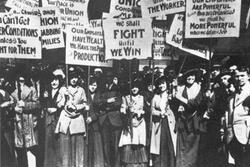Not Just Pink
I am a junior in high school. I’m involved in the mock trial team, the drama department, the creative writing program, and a music club. I’m also on two sports teams: water polo and swimming. I could have also chosen to participate in basketball, or cross country, or tennis, or volleyball, or soccer, or a dozen other sports. I definitely take for granted my opportunities to participate in the athletics and activities of my choice.
When I read the first paragraph of Bobbie Rosenfeld’s biography, I was fascinated. Here was a woman who did not have my privileges, a woman who had to carve her own path in the world of sports. Born in 1904, Rosenfeld played just about every sport I can think of—except for, ironically, swimming. She competed at the 1928 Olympics on Canada’s track team, and took home two medals and a fifth-place award.
For Rosenfeld, sports were not just an outlet for excess energy or a way to pass the time. In Rosenfeld’s world, sports were a way of life. She was such a natural athlete that when a group of friends dared her to enter into the 100-yard dash at a sporting carnival, she competed and beat Rosa Grosse, the reigning Canadian national champion.
Even when things got tough for her, Rosenfeld persevered. A year after her Olympic victories, she was diagnosed with arthritis and was bedridden for a year. However, she was determined to compete with her softball and ice hockey teams, and did so despite her illness. Two years later, she became sick again and was unable to continue her career as an athlete. Despite this, she did not let her sickness end her involvement in the world of sports; Rosenfeld became a track and softball coach and started a sports column in her newspaper. In fact, her story was so inspiring that she is featured on a Canadian stamp.
Rosenfeld not only had incredible athletic abilities, but she was also a great teammate. When Jean Thompson, a fellow team member, entered her first race after recovering from an injury, Rosenfeld could tell that Thompson was nervous and unsure about the event. Even though she had not trained for it, Rosenfeld signed up and ran beside her friend the entire time—letting Thompson finish before her, even though Rosenfeld could have easily overtaken her.
If Rosenfeld were alive today, I believe she would be working to break down gender stereotypes surrounding women in sports. Perhaps she would be advocating for campaigns such as Always’ “Like a Girl,” which warns that the phrase “like a girl” can be harmful to young girls’ self-esteem. The campaign stems from a video in which men and women of all ages are asked to act out what it looks like to “run like a girl,” “fight like a girl,” etc. The resulting footage shows ridiculous flapping arms, hair flips, and the like. The main point of the video, however, is that when young children were asked to “run like a girl,” they simply ran. And when they were asked to “throw like a girl”, there were no half-hearted, limp arm movements. The message struck me as something profound: as we grow older, without even realizing it, we are trained to recognize the phrase “like a girl” to mean “like someone who isn’t capable.” We are trained to see “girl” as a synonym for “incompetent”.
Bobbie Rosenfeld was faced with this challenge too, but there were no flashy public service announcements to help her find her way. All on her own, she made her mark in the world of sports. She was able to see beyond the gender stereotypes of her time, ready and able to take home the gold.
I have never played with a Barbie doll. My baby blanket was not pink, and I’ve never been infatuated with the princesses at Disneyland. I recognize and appreciate the fact that my parents tried hard to ensure that I wouldn’t feel constrained by the restrictions of gender stereotypes. I loved playing with the Megablocks Construction set my parents got me for my second birthday, and I recall numerous Shabbat afternoons spent building cabins with Lincoln Logs. I fondly remember my favorite pair of pajamas: the Thomas the Tank Engine shirt and pants that I would wear almost every night. I found out later that my mom had found them in the boys’ section, because the girls’ section offered only princess pajamas in varying shades of pink. I had dress-up clothes and tea sets, but they sat alongside the Gears! Gears! Gears! building set on my shelf. As I grow older, I realize that my exposure to not just pink, not just dolls, not just princesses, has helped me feel unrestricted as a young adult. I don’t feel pressure to act in a certain way because I am a girl; I don’t feel the weight of gender stereotypes on my shoulders. I do, however, see and feel gender injustices all around me. Shopping at Toys ‘R’ Us, I look around at the pink dollhouses and princess dresses on the left and the blue trucks and transformers on the right. I am appalled by the fact that even in this supposedly modern century, there are different types of toys being offered to young boys and girls, and I stop to think: “What would Bobbie Rosenfeld say?”
This piece was written as part of JWA’s Rising Voices Fellowship.








Thank you for educating us about Bobbie Rosenfeld. She definitely was a great role model, not only for what women can do in sports, but for everyone, by the way she kept persevering in her passion even when she had physical setbacks. I love pink and have some daughters that love pink but never played with barbies. I have one daughter who shuns pink but loves to play with Barbie dolls . She also likes legos. It doesn't bother me that there are separate sections in the toy stores for different kinds of toys. Actually, the legos are in the same side as the dolls and barbies. I hope one day girls and boys will be comfortable playing with both dolls and construction sets. I love when my 12 year old still plays make believe with her dolls. It fosters imagination and creativity. Then she goes and builds a batman Lego car with her brother. Thanks Eliana for your thoughtful and well written blog.
Great move taking on a weighty phrase such as a "like a girl" and reframing it as inducing negative stereotypes. I agree 100% that Toys R Us contributes to gender bifurcation even down to color coding the aisles with blue and pink. Enough is enough. Having said that, I still like women who get mani-pedi's. but not men. I hope there is a line that can still be maintained to distinguish men and women as they still have intrinsic values that biologically separate the sexes beyond just physical attributes. Good job Eliana Melmed.